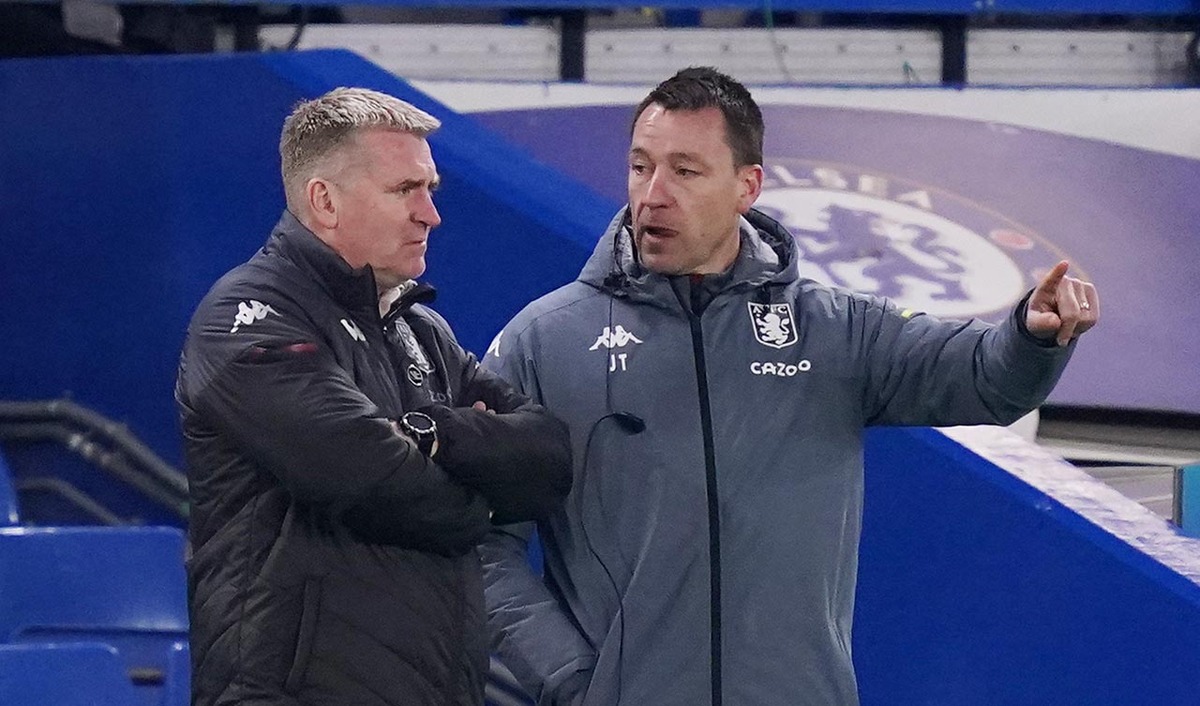




OUR BEST EVER OFFER - SAVE £100/$100
JOIN THE WORLD'S LEADING PROFESSIONAL DEVELOPMENT PROGRAMME
- 12 months membership of Elite Soccer
- Print copy of Elite Player & Coach Development
- Print copy of The Training Ground
You are viewing 1 of your 1 free articles
Defending the box
| Area | Final third of pitch |
| Equipment | Balls, bibs, cones, 6 mannequins, 2 small target goals, 1 full size goal |
| No. of Players | 8 players + 1 goalkeeper |
| Session Time | Press and recover: 5mins Defending crosses: 6mins Defending the box: 7mins |
This session is all about the back four and the real basics of defending. It teaches players that if one player goes for a header, the other defenders should be covering around the area for any flick-ons that they can pick up.
When a player goes up for a header the other three defenders have to always anticipate their player will lose the ball and make sure they are covering at all times, we call this the “what if?” scenario. If your player wins the ball, squeeze up to become a back four again.
We always say to the players: ‘this is one of the most boring bits of the job’ but in some ways it’s one of the most critical. For that reason, it is something we would have as our focus on either a daily or a weekly basis. They might cover around 99 times in a season, but it’s that one time they don’t that could cost us three points and a league position, so it’s always really important to get the basics of defending right. If you do the basics really well, everything else should take care of itself.
The first bit of the session is not about the players enjoying it, but as they progress through the session, the players get out of it what they put in and they will find it beneficial to their roles within the team.
We would run this once or twice a week, usually on a Tuesday and a Thursday. The Tuesday session would be more about us and what our defence needs to focus on as a back four, whereas the Thursday would be more about the coming match and looking at the opposition players and what they do.
We would hold a meeting before the session to focus on the opposition strikers and wingers. We take a look at what they tend to do, what foot they prefer, what their strengths and weaknesses are, and we get our players to consider whether they need to show their opponent inside or outside and whether they need to press them and be engaging them in and around the box.
“The players get out of it what they put in and they will find it beneficial to their roles within the team”
PRESS AND RECOVER
We set up for a moving and covering activity in the final third of the pitch with four mannequins positioned, as shown, and a further mannequin on each of the wings. Two small goals are positioned on the edge of the final third to be used in a later part of the session and a full size goal is in its usual position. We’re using eight outfield players, split into a blue back four and a red back four.
There is no ball in this part of the session as it’s all about the movement by the defenders. When the coach calls the colour of a mannequin, the players react accordingly and take up positions relative to the colour of mannequin called, as shown [1a].
[1a]
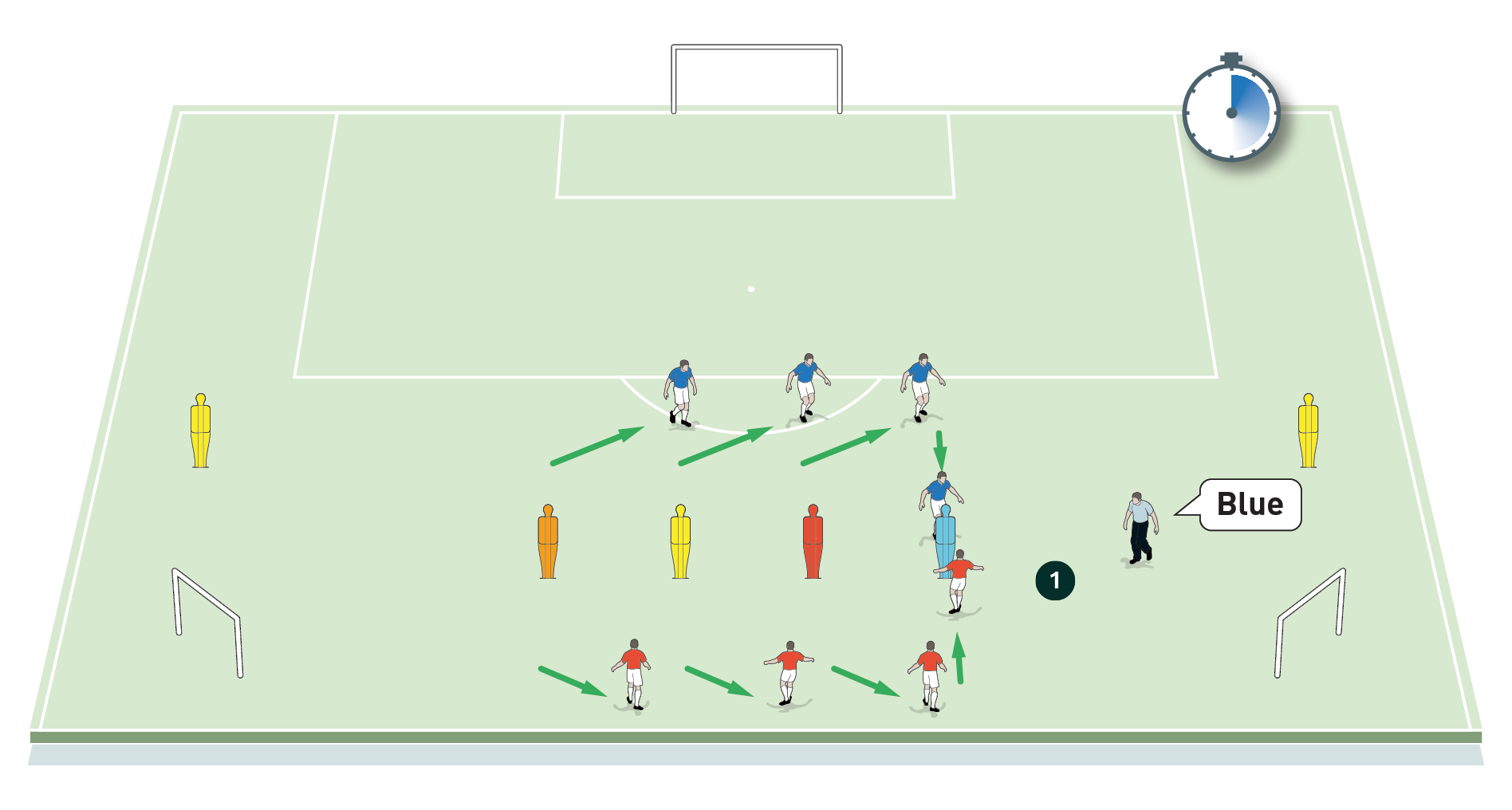
[1b]
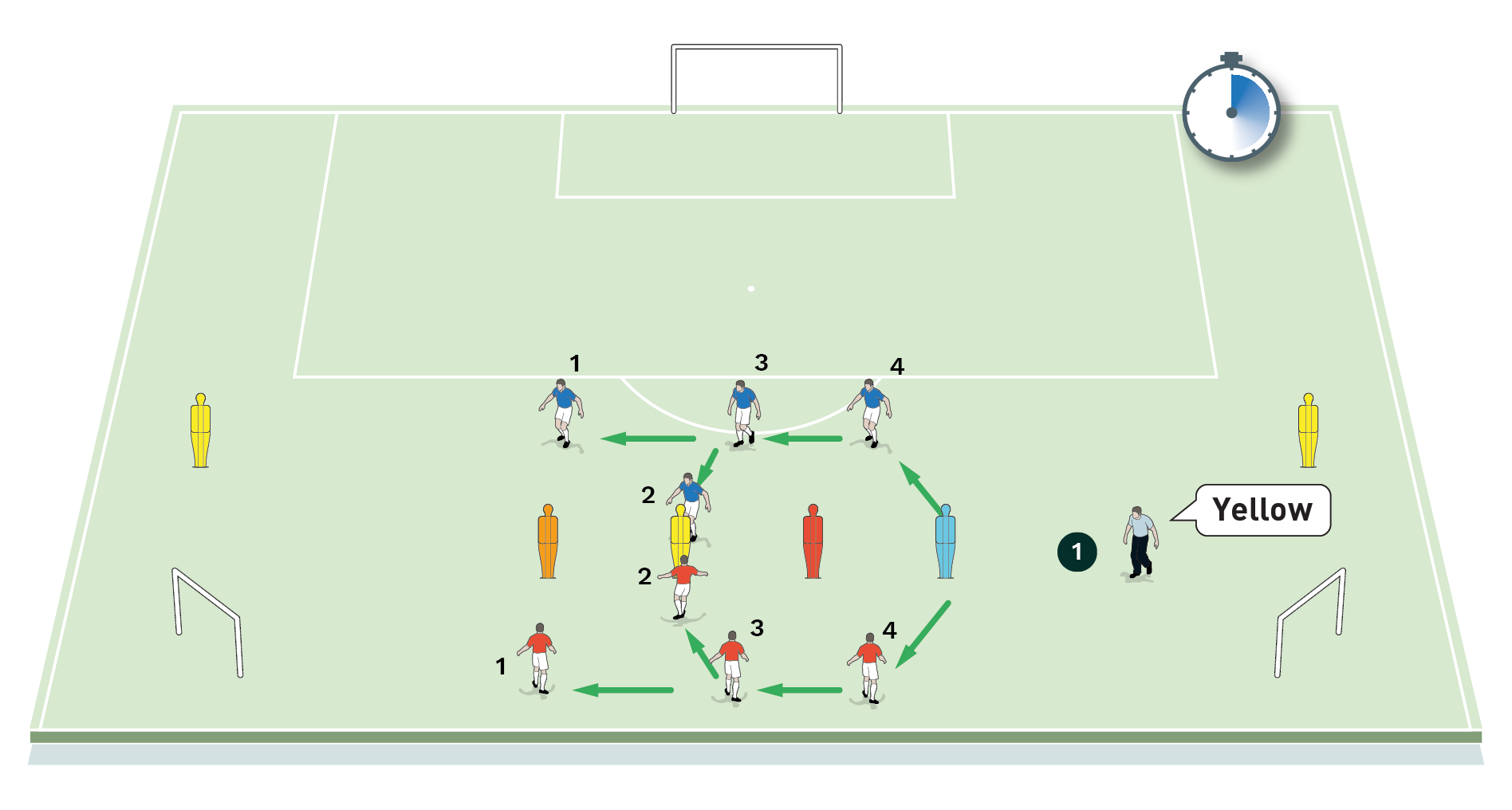
[1c]
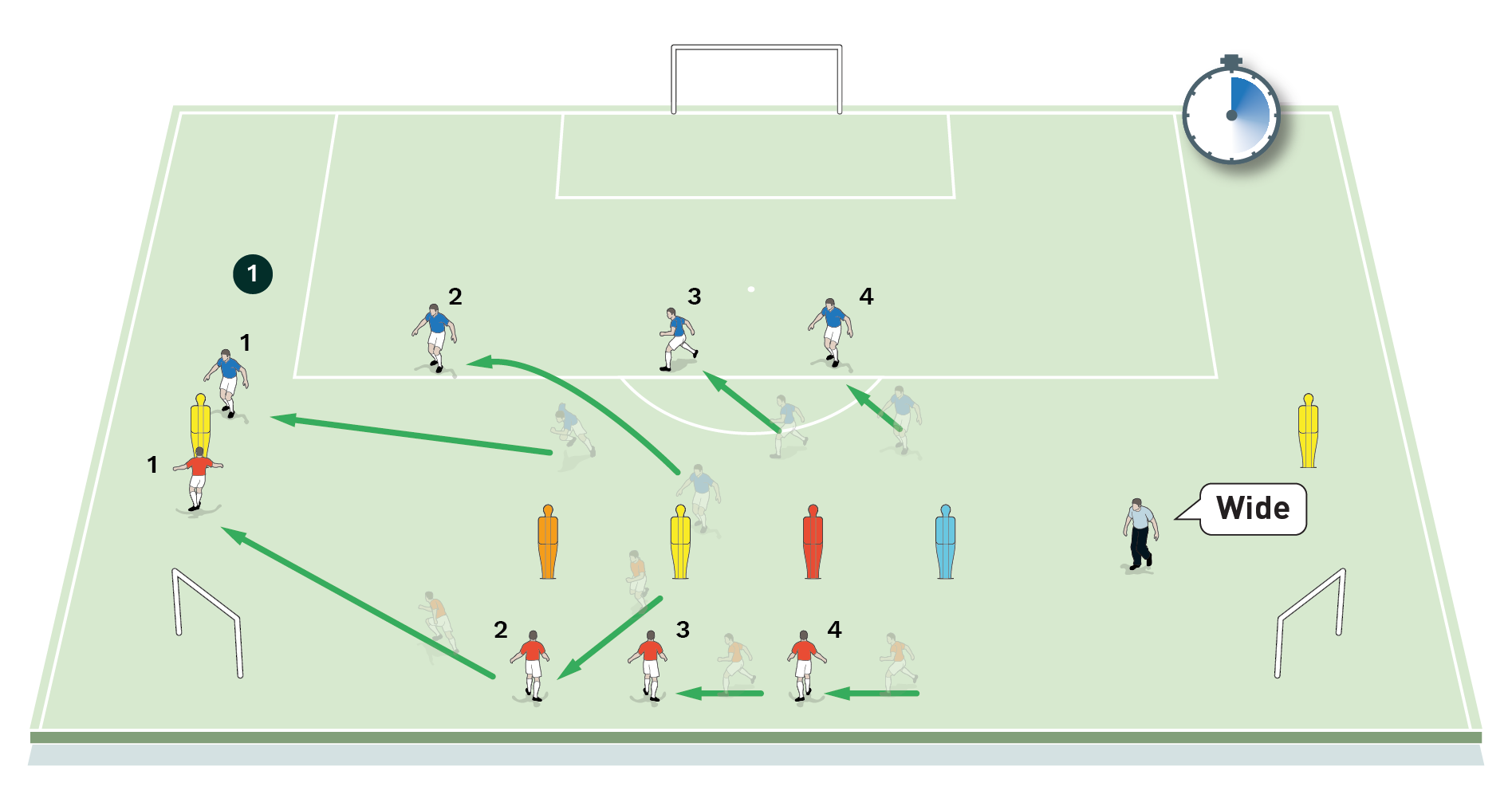
When the coach calls the colour of a different mannequin, the players reposition themselves again, shifting as a unit, with the nearest player pressing the relevant mannequin, as shown [1b].
On calling a wide mannequin, the players must cover a greater area and position themselves accordingly, moving as a unit, as shown [1c].
We would run this in six blocks of 30 seconds, performed at increasing speeds.
“There is no ball in this part of the session as it’s all about movement by the defenders”
DEFENDING CROSSES
We add a goalkeeper to the previous set-up and the small goals are now used as targets for an out ball from the defenders. We’re using a back four defending the goal and two wide attackers on each flank, who must combine at match tempo to deliver crosses into the penalty area. We want to see the back four focus on heading, making clearances into safe areas, and using clear communication and good covering play.
We use the mini goals as an out ball, can we turn our clearances into passes? These are the positions we work on our wide players to be in so we can get on the attack. If this isn’t possible, a good connection on the ball to put out for a throw in as we don’t take any risks.
When the wide players cross the ball into the penalty area, the defenders should position themselves to clear the ball into the small goals if possible, as shown [2a]. The coach stands outside the penalty area and can shoot at goal if he picks up any poor clearances. We run it with three sets of two crosses from each side and we change the back four.
Next we use the same set-up, but this time the goalkeeper starts play by passing the ball out wide to the opposition attacker and the full back must sprint out to try and block the cross, as shown [2b].
[2a]

2. The defenders should position themselves to clear the ball into the small goals
3. The coach stands outside the penalty area and can shoot at goal if he picks up any poor clearances
[2b]
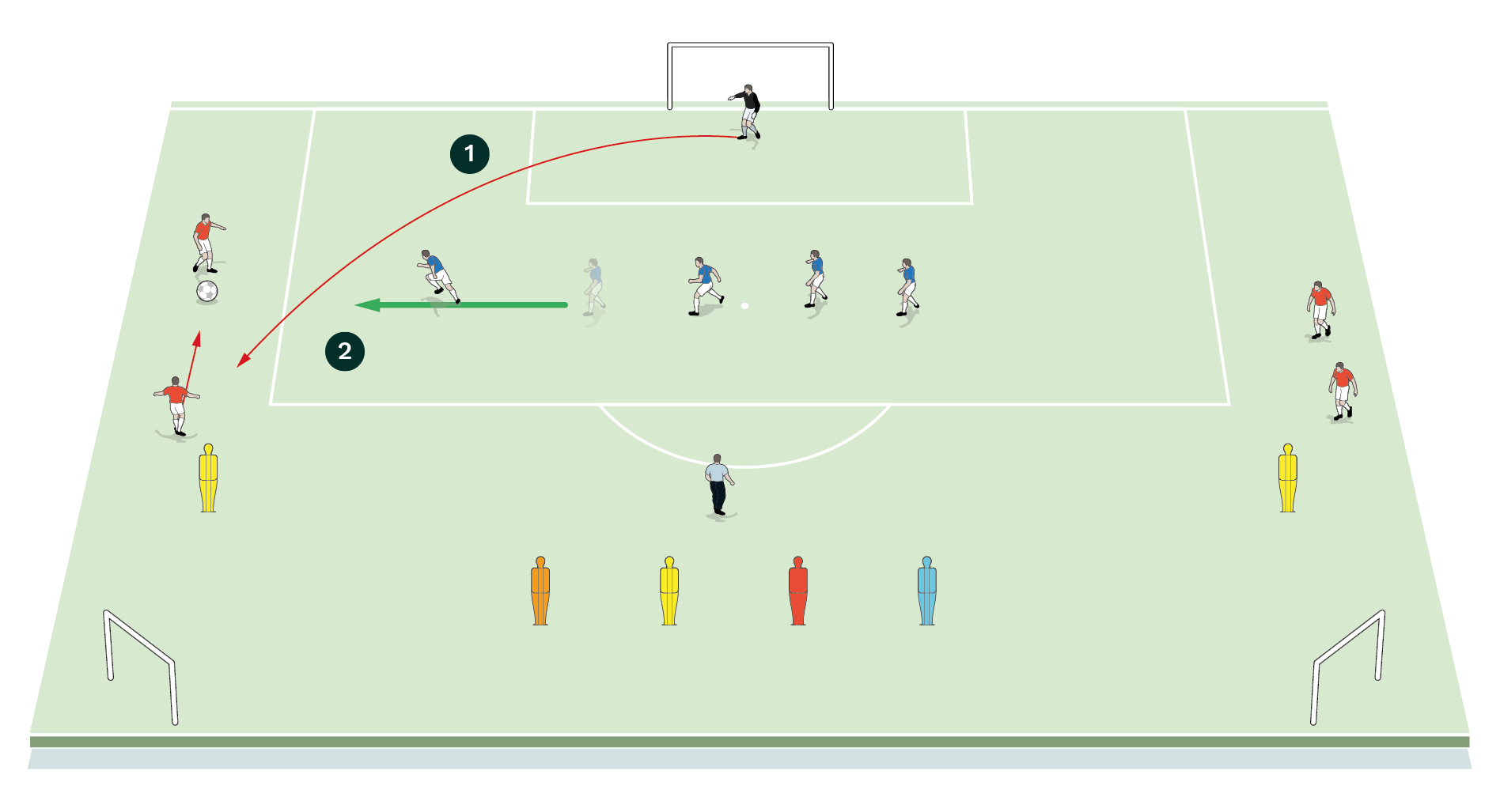
2. The full back must sprint out to try to block the cross
[2c]
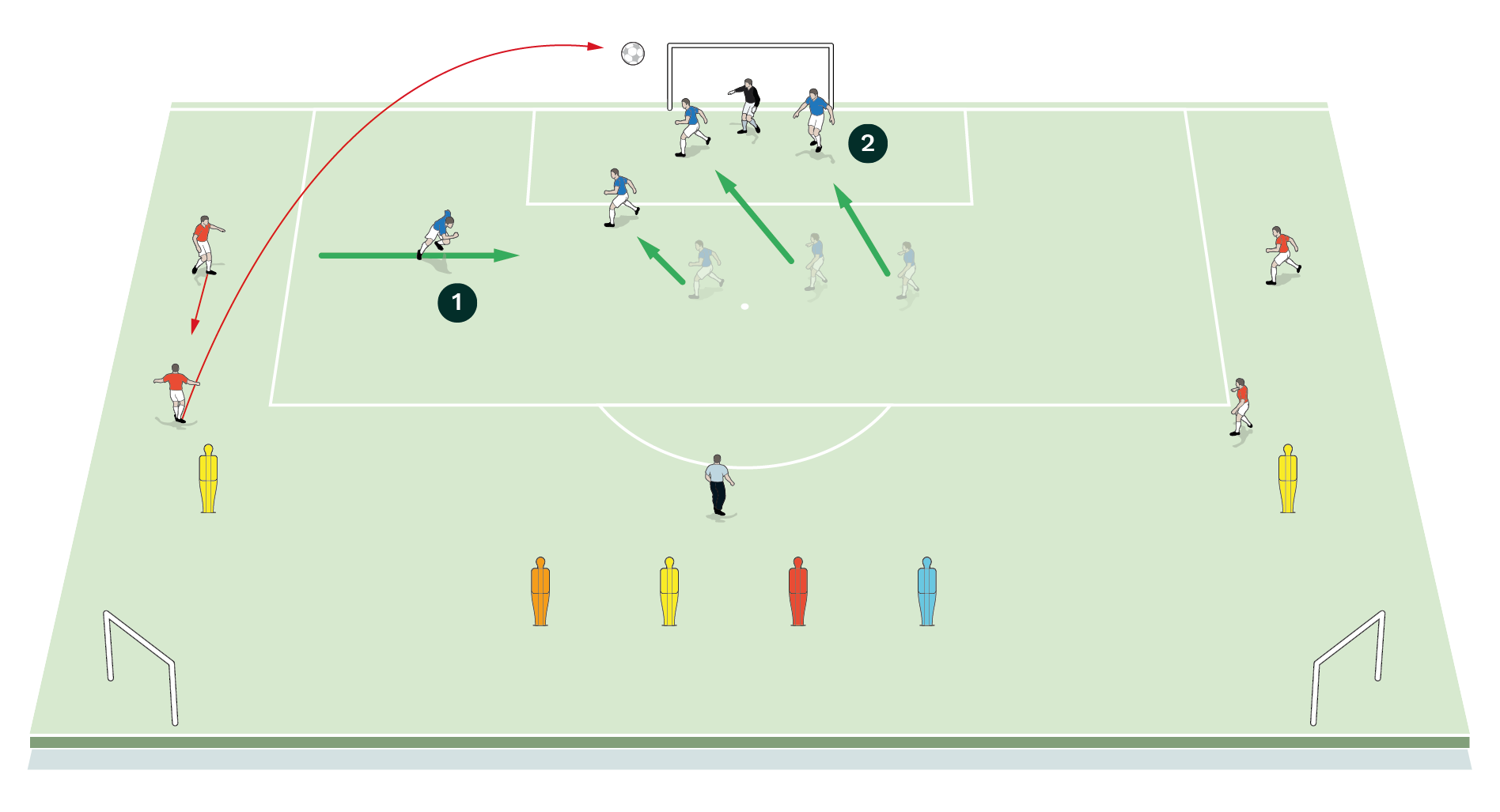
2. Another defender drops to protect the goalkeeper and a third covers the keeper
[2d]
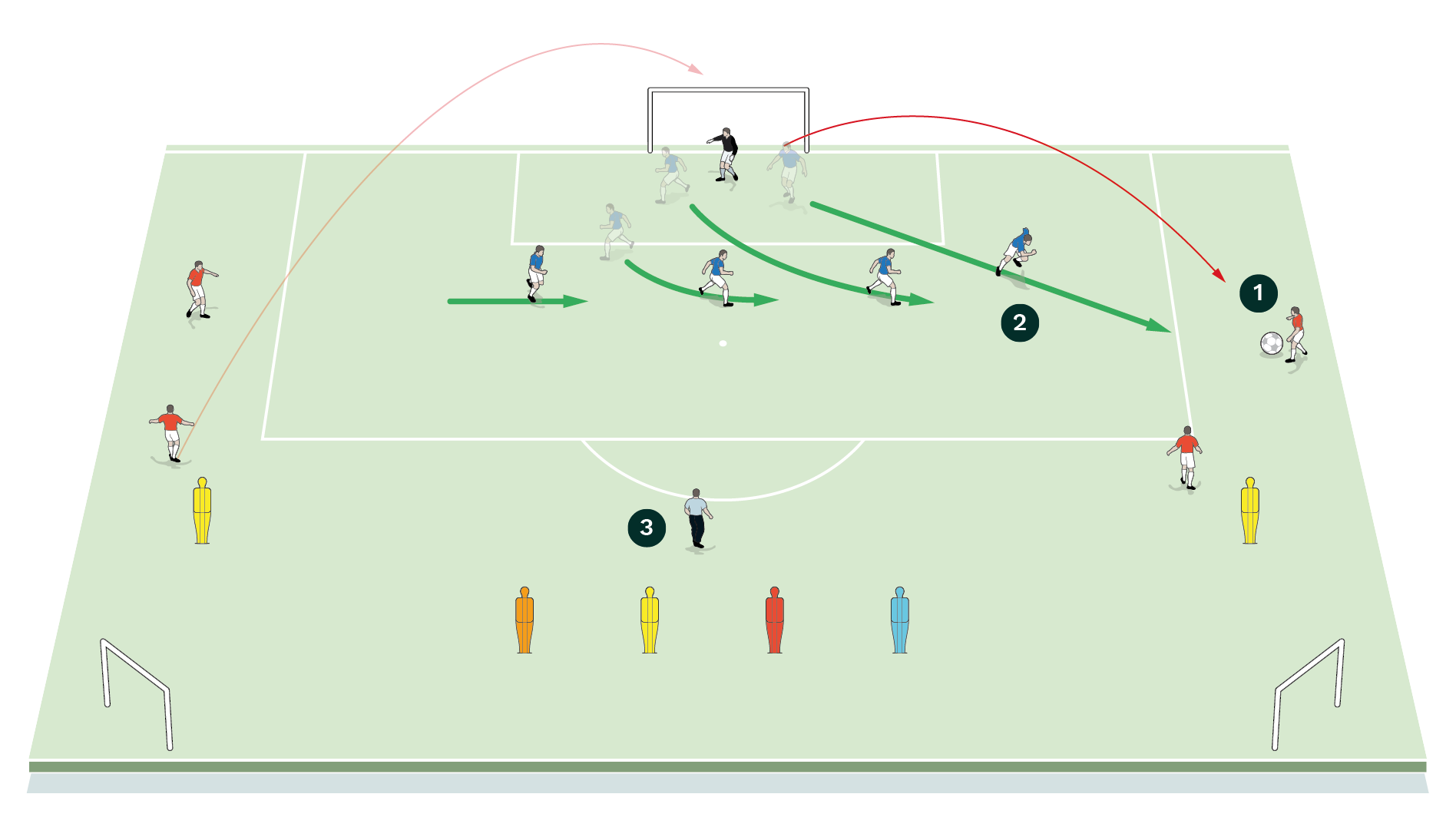
2. The back four position themselves according to the threat and the nearest presses the ball
3. The coach stands outside the penalty area and can shoot at goal if he picks up any poor clearances
If he fails to block the cross, he must quickly recover back inside the penalty area to pick up any rebounds and knockdowns, while another defender protects the goalkeeper and a third covers him, as shown [2c]. If the cross reaches the opposite wing or is cleared there, play continues without interruption, with the wide attacker on that side crossing back into the penalty area and the back four positioning themselves accordingly, as shown [2d]. Again, the coach stands outside the penalty area and can shoot at goal if he picks up any poor clearances. We run it with three sets of two crosses from each side, changing the back four as needed.
If we have any extra players, we can progress the activity by getting them to act as strikers.
DEFENDING THE BOX
[3a]

2. The goalkeeper collects the ball and distributes to one of the wide attacking players
3. The nearest defender presses the ball
“We want to see the defending team shifting and moving together, getting pressure on the ball, stopping shots and clearing crosses”
Using the same set-up as in the previous activity, the four attackers now position themselves as two strikers and two wide players. The back four line up as normal. The aim for the attackers is to try and circulate the ball to set up shooting or crossing opportunities.
The coach begins play with a shot at goal, which the defenders attempt to block. The goalkeeper collects the ball and distributes to one of the wide players, as shown [3a], while the nearest defender presses the ball. When the ball moves inside, the defenders move across as a unit, replicating the movements practised in the first exercise, as shown [3b].
[3b]
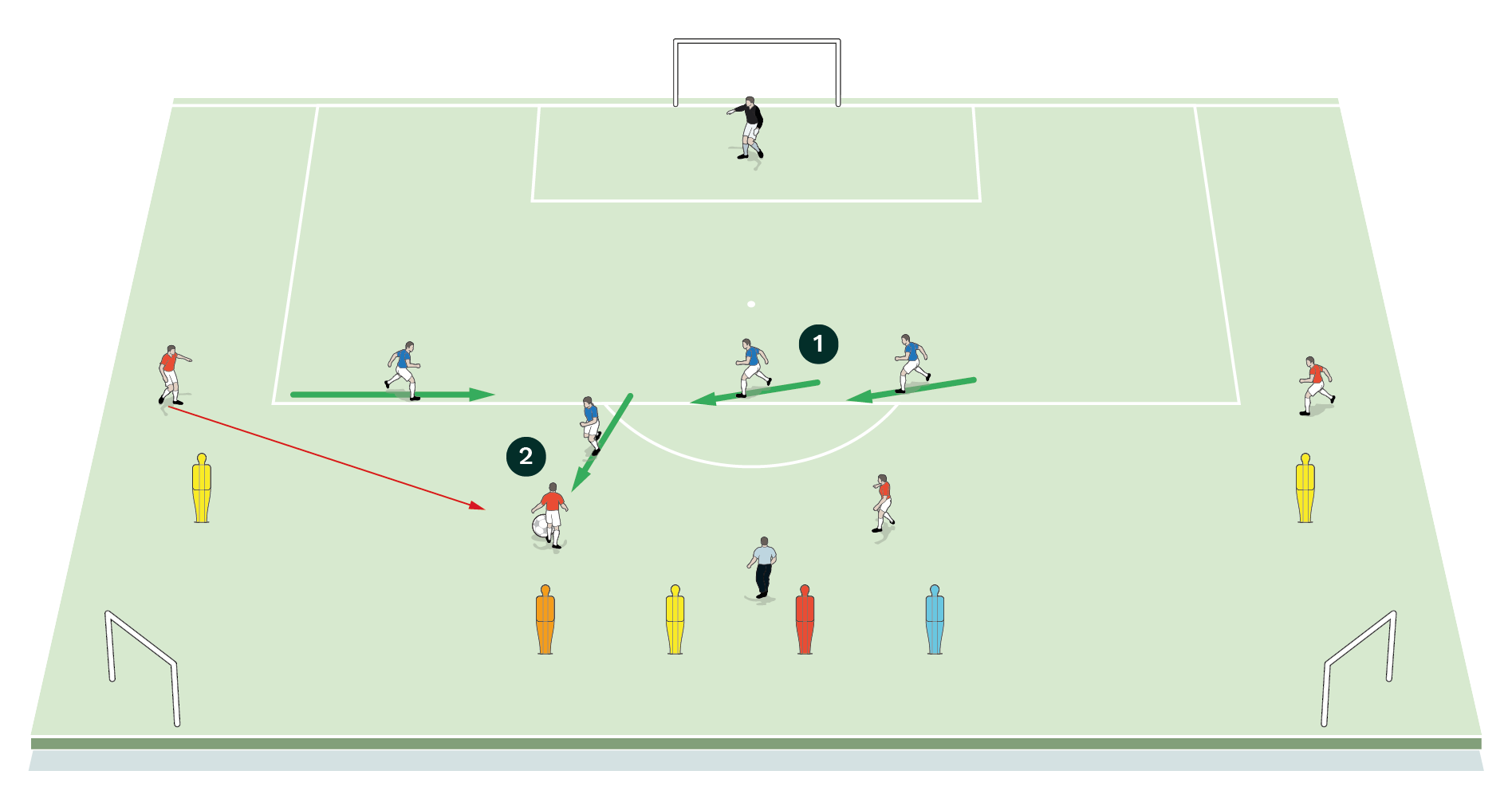
2. The nearest defender presses the ball
[3c]
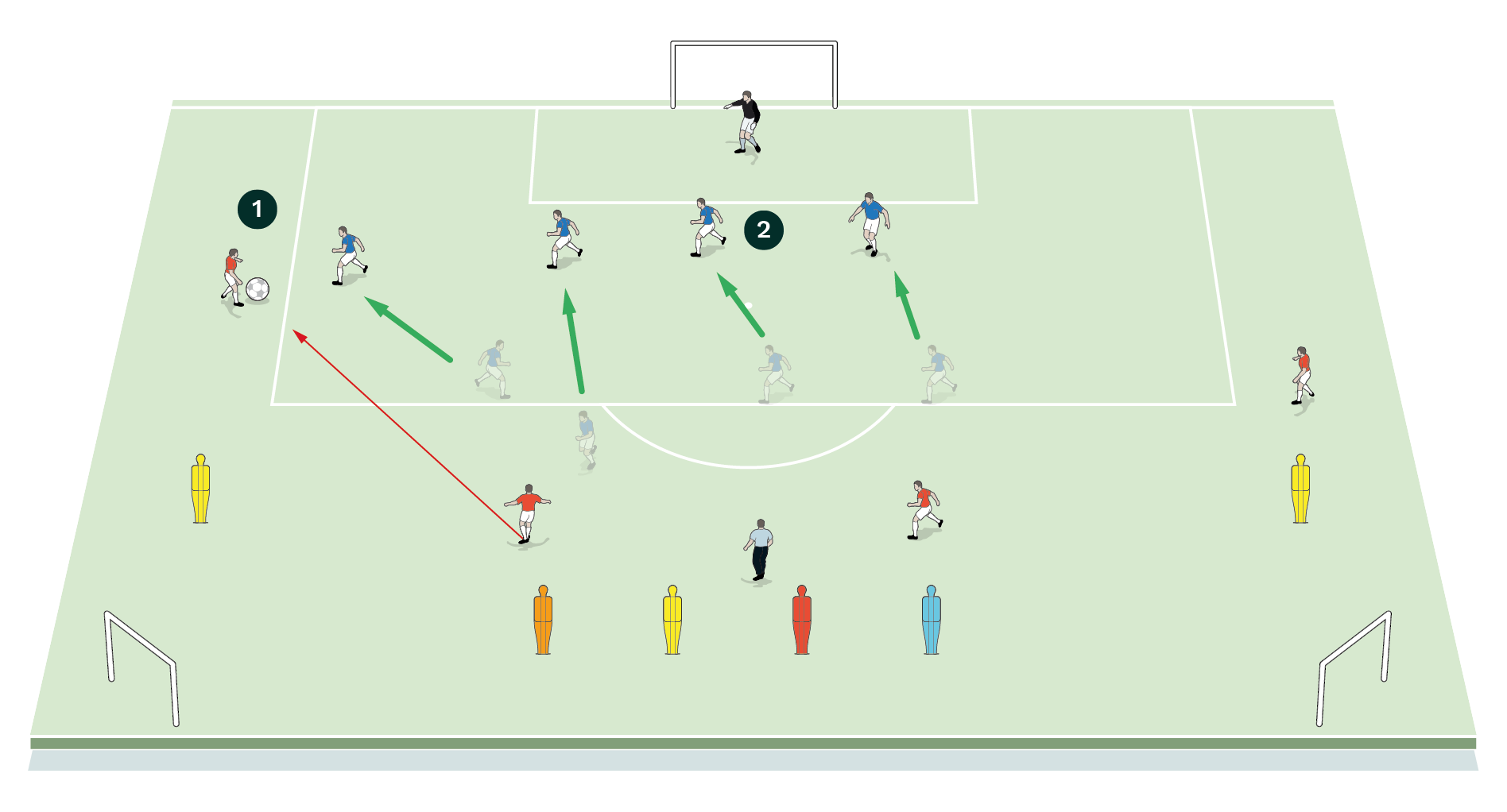
2. One defender drops to protect in front of the goalkeeper and one covers behind
When the ball goes into a crossing position, the defenders drop deeper with one defender protecting in front of the goalkeeper and one covering him behind, as shown [3c].
We want to see the defending team shifting and moving together, getting pressure on the ball, stopping shots and clearing crosses.
Play always restarts with a throw from the goalkeeper. We play for six minutes.
Related Files
Editor's Picks
Attacking transitions
Deep runs in the final third
Using the goalkeeper in build-up play
Intensive boxes drill with goals
Penetrating the final third
Creating and finishing
My philosophy
Pressing initiation
Compact team movement
Coaches' Testimonials

Alan Pardew

Arsène Wenger

Brendan Rodgers

Carlos Carvalhal

José Mourinho

Jürgen Klopp

Pep Guardiola

Roy Hodgson

Sir Alex Ferguson

Steven Gerrard
Coaches' Testimonials

Gerald Kearney, Downtown Las Vegas Soccer Club

Paul Butler, Florida, USA

Rick Shields, Springboro, USA

Tony Green, Pierrefonds Titans, Quebec, Canada
Join the world's leading coaches and managers and discover for yourself one of the best kept secrets in coaching. No other training tool on the planet is written or read by the calibre of names you’ll find in Elite Soccer.
In a recent survey 92% of subscribers said Elite Soccer makes them more confident, 89% said it makes them a more effective coach and 91% said it makes them more inspired.
Get Monthly Inspiration
All the latest techniques and approaches
Since 2010 Elite Soccer has given subscribers exclusive insight into the training ground practices of the world’s best coaches. Published in partnership with the League Managers Association we have unparalleled access to the leading lights in the English leagues, as well as a host of international managers.
Elite Soccer exclusively features sessions written by the coaches themselves. There are no observed sessions and no sessions “in the style of”, just first-hand advice delivered direct to you from the coach.
